vatican
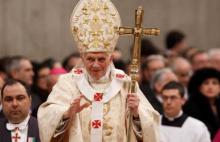
VATICAN CITY — The Vatican reaffirmed its commitment to dialogue with Jews on Monday after the head of a traditionalist breakaway group called them “enemies of the Church.”
The Vatican chief spokesman, the Rev. Federico Lombardi, said that it was “meaningless” and “unacceptable” to label Jews as “enemies” of the Catholic Church.
“Both Pope Benedict XVI and his predecessor John Paul II personally engaged in dialogue with Jews,” he said. As a sign of their commitment, Lombardi noted the two popes’ visits to Jerusalem’s Western Wall, Judaism’s most sacred site, and to synagogues in Rome and elsewhere.

VATICAN CITY — Exactly 500 years ago, on Oct. 31, 1512, Pope Julius II led an evening prayer service to inaugurate the Sistine Chapel and Michelangelo's newly-finished vault frescoes.
But as Pope Benedict XVI on Wednesday celebrated the 500th anniversary of the Renaissance masterpiece, the Vatican said the growing number of tourists who visit the historic site every year might eventually lead to limiting access to the chapel to help preserve the frescoes from human-born problems and pollutants.
“We could limit access, introducing a maximum number of entries,” wrote Antonio Paolucci, the director of the Vatican Museums, in L'Osservatore Romano, the Vatican's semi-official newspaper. “We will do this, if the pressure from tourism were to increase beyond a reasonable level and if we were to fail in resolving the problem efficiently.”
Paolucci stressed, however, that in his opinion such measures will not be necessary “in the short to medium term.”
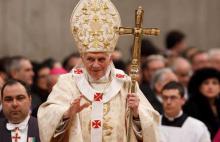
VATICAN CITY — Fifty years after the Second Vatican Council revolutionized life inside the Roman Catholic Church, hundreds of bishops from around the world are gathered in Rome to confront an external threat: a mounting tide of secularization.
The Synod of Bishops on “New Evangelization” brings together 262 top church leaders for a three-week summit at the Vatican, joined by lay experts and representatives of other Christian groups.
In a wide-ranging speech aimed at setting the tone for the bishops' discussion, Washington Cardinal Donald Wuerl called on Christians to “overcome the syndrome of embarrassment” about their faith with a more assertive offense against the “tsunami of secular influence” that is sweeping away “marriage, family, the concept of the common good and objective right and wrong.”
Wuerl has been appointed by Pope Benedict XVI as the “relator general” of the synod, with the key task of summing up the main points of the bishops' discussions.

The Vatican's newspaper has declared the controversial “Jesus wife” papyrus fragment “a fake."
L'Osservatore Romano on Friday (Sept. 28) devoted two articles to Harvard professor Karen King's claim that a 4th century Coptic papyrus fragment showed that some early Christians believed that Jesus was married.
The announcement of the discovery on Sept. 18 made headlines worldwide but was met with skepticism by scholars who questioned the authenticity of the fragment.
In the Vatican daily, a detailed and critical analysis of King's research by leading Coptic scholar Alberto Camplani is accompanied by a punchy column by the newspaper’s editor, Giovanni Maria Vian, who is a historian of early Christianity.
Vian writes that there are “considerable reasons” to think that the fragment is nothing more than a “clumsy fake.” Moreover, according to Vian, King's interpretation of its content is “wholly implausible” and bends the facts to suit “a contemporary ideology which has nothing to do with ancient Christian history, or with the figure of Jesus”.
“At any rate, it's a fake,” he concludes.

An Illinois priest who was forced out of his parish by his bishop for improvising prayers during Mass has had his suspension reversed by the Vatican.
The Vatican decided in favor of the Rev. William Rowe on one of three counts, saying Bishop Edward Braxton of Belleville, Ill., had not followed the proper procedure.
The Vatican's reversal means he can celebrate Mass in another diocese, Rowe said, as long as he has the local bishop's approval. Others, however, disputed that interpretation of the decree.
In a letter that accompanied the document, Monsignor Antonio Neri, an undersecretary of the Vatican's Congregation for the Clergy, said Rowe could only return to celebrating Mass “when you shall have acknowledged your error and formally promise to dispose yourself to adhere to the rights and rubrics of the sacred liturgy set down by the lawful ecclesiastical authorities.”
The Vatican sided with the bishop on two counts: upholding his removal from the parish, and agreeing with the bishop's withdrawal of the priest's "faculties" — or his license to practice ministry under church law.
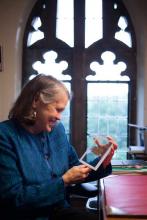
In a surprise announcement that seemed scripted by the novelist Dan Brown, a Harvard professor revealed an ancient scrap of papyrus on Tuesday (Sept. 18) that purports to refer to Jesus' wife.
The so-called "Gospel of Jesus' Wife" presents a dialogue between Jesus and his disciples, said Karen King, a well-respected historian of early Christianity at Harvard Divinity School.
The fourth-century fragment says, "Jesus said to them, 'My wife ...,'" according to King. The rest of the sentence is cut off. The fragment also says "she will be able to be my disciple," according to King.
The discovery that some ancient Christians thought Jesus had a wife could shake up centuries-old Christian traditions, King suggested.
But even King acknowledged that questions remain about the receipt-sized scrap, which contains just 33 words and incomplete sentences. Here are five of the biggest questions.

The Vatican confirmed on Wednesday that Pope Benedict XVI's visit to Lebanon will go ahead as planned, despite growing tension in the region after the killing of the U.S. ambassador to Libya by a mob enraged by an anti-Islam film.
The Vatican's chief spokesman, the Rev. Federico Lombardi, said the Vatican was closely monitoring developments in the region but there were no signs of specific security concerns for Benedict's trip so far.
Benedict is scheduled to leave Friday for a three-day visit to Lebanon despite rising instability spilling over from a deadly civil war in neighboring Syr
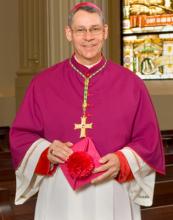
Finn, leader of the Diocese of Kansas City-St. Joseph and an outspoken conservative in the American hierarchy, was convicted of a single misdemeanor count for not telling police that one of his priests, the Rev. Shawn Ratigan, had taken hundreds of lewd images of children in Catholic schools and parishes.
But even as he became the first U.S. bishop ever convicted in criminal court for shielding an abusive priest, Finn’s standing inside the church appears uncertain, and the subject of intense debate.
Should he stay or should he go? Finn has indicated that he wants to tough it out.

EVER SINCE THE apostles positioned Mary Magdalene as an “unreliable narrator” telling an “idle tale” in Jesus’ resurrection story, some men in the church have claimed maleness as normative and orthodox and femaleness as, well, not.
In the recent case of the Vatican vs. the Leadership Conference of Women Religious (LCWR), the integrity of women’s witness is, once again, called into question by male hierarchs.
These Catholic sisters represent an unbroken, cohesive expression of faith in the history of American Catholicism and in women’s presumption of equality, completeness, and active moral agency both under law and under God—a presumption that is a shining light for women around the world. The sisters might have once shared accolades for faithful servant leadership with their brother priests, bishops, and cardinals, but over the course of nearly 30 years of unfolding pedophilia scandal and blasphemous mob-like cover-up, the laity has learned to look to the sisters alone for examples of Catholic gospel witness and Christian maturity, strength, and just plain grit.
But let’s not sideline this issue as “a Catholic thing.” We don’t get off that easy. The struggle over women’s authority runs right through the denominational diaspora of the body of Christ.

AS AN AUTHOR whose book sales have, shall we say, peaked, I took particular interest in the rising popularity of Just Love: A Framework for Christian Sexual Ethics, by Catholic Sister Margaret Farley. Until recently, her book had enjoyed only modest success, the predictable result of a title that gets the public’s blood racing with “sexual,” then quickly disappoints with the word “ethics,” the marketing equivalent of taking a cold shower while wrapped in a wet blanket. Toss in the word “Christian” and your sales possibilities are further reduced to a half dozen seminary students still looking for a thesis topic.
All of which violates the advice my grandmother gave me years ago: “Put sex in a book title, honey, and it’s money in the bank.” At least I think it was my grandmother.
But then a miracle happened. When officials at the Vatican read the book—between pensive walks in long robes (that’s what they do in the movies)—they were shocked and stunned, and immediately (six years later) declared it scandalous. This caused sales of Just Love to skyrocket. (Which proves the other thing my grandmother said: “No wait. I got it wrong. Have the Vatican criticize your book and then it’s money in the bank.”)
Vatican officials objected to Sister Farley’s frank theological exploration of modern sexuality which, anyone could have told her, is just not done when affiliated with a powerful religious institution that thinks “modern” means “the most recent part of the Middle Ages.” And back then, people didn’t talk about gay marriage or masturbation or any of the other issues Sister Farley thoughtfully ponders, not without enjoying the church’s hospitality sitting in wooden stocks for a few days.
Agencia Fides, the Vatican news outlet for Catholic missioners, is the only news source for reports about Mussalaha, the popular faith-led peace movement in Syria. With violence fracturing along religious/ethnic lines, this inter-religious movement seeks to maintain safe havens for all Syrians who will lay down their weapons. Mussalaha is also smuggling food, medicine, and hope into blockaded cities, such as Rableh where more than 12,000 Christians have been under siege for more than 10 days.
Agencia Fides reports: Over 12 thousand faithful Greek-Catholics are trapped in the village of Rableh, west of Qusayr, in the area of Homs. Food is scarce, the faithful are living on "bread and water", medicine is lacking to treat the sick and wounded. This is the alarm raised by local sources of Fides that invoke respect for humanitarian law, that confirm what the international press is reporting on the situation in Rableh. For more than ten days the village of Rableh is subject to a strict blockade by armed opposition groups, which surround it on all sides....
...representatives of the popular initiative for reconciliation "Mussalaha" were able to carry a small load of humanitarian aid to the village. A representative of "Mussalaha" assured the faithful by claiming that "everything will be done to allow the delivery of humanitarian aid." An appeal was launched by His Beatitude Patriarch Gregorios III Laham, visibly moved, to all men of good will so that "Rableh is saved and all other villages affected in Syria, and finally for peace to be reached in our beloved country." Even the Apostolic Nuncio in Syria, His Exc. Mgr. Mario Zenari, called on all parties involved "to the strict observance of the international humanitarian law", pointing out that the resolution of the crisis in Syria depends first of all on its citizens.
Read the whole article.
A federal judge on Monday dismissed the Vatican from a lawsuit filed by a former Portland teenager who says he was sexually abused by a pedophile priest who was transferred from Ireland to Chicago and then Portland in an alleged church effort to hide his past.
U.S. District Judge Michael Mosman of Portland said the Vatican didn't employ the Rev. Andrew Ronan, who — according to the lawsuit — molested the teenager in 1965 and 1966. Mosman's ruling means the Vatican can't be held financially liable for the abuse.
"It's clearly a disappointment, but we're definitely not discouraged," said Jeff Anderson, the Minnesota attorney who is representing the victim, listed in the suit as John V. Doe.
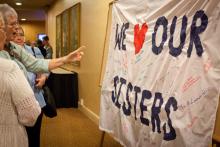
A leader of the group of Catholic nuns who are facing a crackdown from the Vatican said on Thursday that her members have no plans or desire to leave the church, or reconstitute their group beyond Vatican control.
Sister Mary Hughes, who ended a three-year term as president of the Leadership Conference of Women Religious on Aug. 11, said there is little-to-no support to withdraw the LCWR from the church, where it could avoid a Vatican-order makeover.
"It is the deep desire of the membership to stay within the church and not move away from it," Hughes said at a luncheon at the National Press Club. "We derive our strength from the sacramental life of the church."

The 2012 presidential campaign could bear a new subtitle: A Tale of Two Catholics.
For the first time in U.S. history, both sides of the ballot include Roman Catholics: Democrats’ Vice President Joe Biden, and Republicans' newly named vice presidential candidate Paul Ryan.
Ryan, 42, still belongs to the Catholic parish, St. John Vianney in Janesville, Wis., where he was an altar boy. Biden, 69, the first Catholic vice president in U.S. history, attends Mass at St. Patrick’s Parish and St. Joseph on the Brandywine Church, both in Wilmington, De.
Biden and Ryan both cite their faith as a formative influence, but neither is known as a standard-bearer for the Catholic hierarchy’s chief political causes: abortion and gay marriage. In fact, the two candidates are — politically at least — nearly polar opposites.

American nuns facing a Vatican takeover of their leadership organization on Aug. 10 rejected Rome’s plans to recast the group in a more conservative mold, but declined — for now — to respond with an ultimatum that could have created an unprecedented schism between the sisters and the hierarchy.
Instead, the nuns said they wanted to pursue a negotiated solution to the showdown that has galvanized American Catholics in recent months and prompted an outpouring of support for the sisters that left the Vatican with a black eye.
The statement from the Leadership Conference of Women Religious came at the end of the LCWR’s annual assembly here and was the first formal response to the Vatican from the entire organization, which represents most of the 56,000 nuns in the U.S.
The Vatican announced in April that it was assigning a team of bishops to take control of the LCWR in order to make the organization — and by extension, most U.S. nuns — hew more closely and publicly to orthodox teachings on sexuality and theology.
Sister Pat Farrell, the outgoing president of the LCWR, on Friday read the official response that expressed the organization’s “deep disappointment” with Rome’s verdict. But the statement also said the nuns wanted to keep talking with the hierarchy in hopes of “creating more possibilities for the laity and, particularly for women, to have a voice in the church.”

I grew up thinking a lot of things were evil: cursing, smoking, Texas A&M, Democrats.
But one thing that never fell into the “damned” category was yoga. I guess it just didn't come up. So I was more than a little confused when a few years ago, pastors across the religiously affiliated spectrum started condemning my workout class of choice.
Seattle megachurch pastor Mark Driscoll has said multiple times yoga is evil, concluding, “A faithful Christian can no more say they are practicing yoga for Jesus than they can say they are committing adultery for Jesus.” Southern Baptist Theological Seminary president Albert Mohler said — and was later lambasted for it — that embrace of yoga is contradictory to Christian commitment. Even the guy at the Vatican who does exorcisms said yoga is the “work of the devil.”
To which my initial response — to quote the Dude — is … well, y’know, that’s just, like your opinion, man. (Er, I mean men. White pastorly men.)
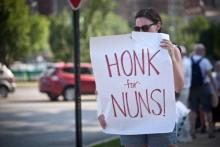
Catholic sisters gathered in St. Louis for their annual assembly on Thursday intensified discussions aimed at thwarting a Vatican takeover of their group, but hanging over the meeting was an even larger existential question: Do the nuns have a future?
The viability issue is central to the dispute between Rome and the nuns that has riveted Catholics and dominated this year's meeting of the Leadership Conference of Women Religious. The steering group represents most of the 56,000 nuns in religious orders in the United States.
The Vatican announced in April that a team of bishops would take control of the LCWR in order to make the nuns hew more closely and publicly to orthodox teachings on sexuality and theology. The sisters are expected to deliver their first formal reply to the takeover on Friday.
A key justification for Rome's action was the argument that vocations to more progressive women's religious communities are in free fall: In 1965 there were 180,000 sisters in religious life, more than three times today's number. The decline is especially acute in orders that belong to the LCWR.

As hundreds of nuns met in St. Louis on Wednesday to begin crafting an answer to Vatican demands that their leaders toe the line on orthodoxy, there was a pervasive sense that this week's discussions could lead to a fateful juncture in the history of Catholicism in America.
"As you know, this is an assembly like no other assembly we've had," said Sister Pat Farrell, a Franciscan from Iowa who heads the Leadership Conference of Women Religious, which represents most of the 56,000 nuns in communities across the country.
"I suspect we're in for a lot of surprises," Farrell told the sisters as she opened the LCWR's annual meeting.
The options under consideration by the 900 nuns — several hundred more than have attended recent gatherings — range from asking the Vatican to continue the dialogue to shuttering the LCWR and reorganizing the leadership body of sisters into a group that would be beyond the Vatican's control.
But that would also signal a historic shift in a church in which the nuns for centuries simply did the work that the bishops preached about — serving the poor, caring for the sick, and educating the young.
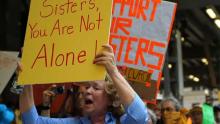
Fifty years after Pope John XXIII convened the Second Vatican Council to modernize the Roman Catholic Church, the legacy of that watershed summit that revolutionized Catholic life is at the core of a dispute between the Vatican and American nuns.
In April, the Vatican accused the Leadership Conference of Women Religious (LCWR), the umbrella group that represents the majority of American nuns, of “doctrinal confusion.” As LCWR leaders meet this week (Aug. 7-11) to plot their response to the Vatican, many of the sisters say they are just following the spirit of Vatican II.
“This is not just about the Vatican versus the nuns. This really is about the future of how we interpret the message of the Second Vatican Council,” Sister Maureen Fiedler told the PBS program “Religion & Ethics NewsWeekly.”

MOHAWK VALLEY, New York — Twelve-year-old Jake Finkbonner leaned over and ran his hand through a pool of water from a natural spring at the National Shrine of Blessed Kateri Tekakwitha, in Fonda, N.Y.. With that simple gesture, on a recent July weekend, the boy connected literally to the story of the 17th-century Native American woman who the Roman Catholic Church will elevate to sainthood on Oct. 21.
Jake had already connected to her story in what he believes is a miraculous way. The boy's inexplicable recovery from a flesh-eating illness in 2006 is attributed to prayers to Kateri (pronounced Gad-a-lee in Mohawk) on his behalf.
Jake, who is of Lummi descent, said he's gotten used to the attention he draws when people learn he's at the center of the miracle that led the Vatican to decide to proclaim Kateri a saint — a step that will make her one of the church's holy role models, and the first Native American to be canonized.
He likes to read and play basketball, and he loves video games. He and his 10-year-old sister, Miranda, are also training to become altar servers.
"I feel a great amount of gratitude and thanks to her," Jake said of Kateri.